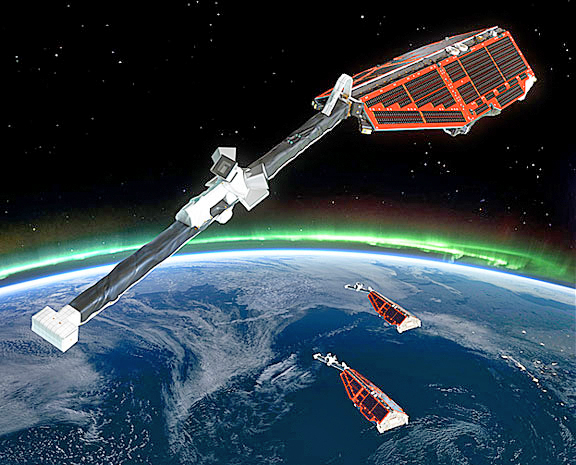
Artistic rendition of the three satellites that will comprise ESA's SWARM mission.
The magnetic field surrounding the Earth is of vital importance for life on the planet. Together with the atmosphere it acts as a protective layer that shields us from dangerous radiation emitted by the sun, known as the solar wind. The Earth’s interior is structured like an onion, with a solid inner core at its center surrounded by a liquid outer core of molten nickel and iron. Electric currents generated in this swirling mass of liquid metal create magnetic fields, and so—combined with the effects of the Earth’s rotation—the structure acts like a giant dynamo to create the geomagnetic field.
This explains why the interior of our planet is of such great interest to scientists, who are just as keen to unlock its secrets as they are to explore the mysteries of space and the surface of the globe. The three satellites for ESA’s new Swarm mission will orbit at different altitudes between 400 and 550km to carry out the most accurate survey to date of the geomagnetic field and record any changes occurring in it.
The accuracy of this survey mission depends on scientists being able to keep track of where each satellite is at any given moment and to ensure they stick to their intended flight path. That’s why the satellites use signals from the United States’ GPS (global positioning system) satellite navigation system for attitude control.
RUAG Space in Vienna developed the innovative, space-hardened GPS receivers and tailored them to meet precise orbit determination (POD) requirements. Unlike the GPS receivers commonly used in terrestrial applications, these devices are capable of simultaneously processing signals received at two different frequencies, and thus delivering positioning information of the highest accuracy. Their design is based on application-specific integrated circuits (ASICs), which makes for an extremely lightweight device that at the same time complies with all necessary requirements for reliability and resistance to radiation for deployment in space.
An international team led by RUAG Space in Austria and including the Swedish unit RUAG Space AB and Spanish technological business group GMV built and tested the receivers, which were then delivered to prime contractor Astrium GmbH in Friedrichshafen, Germany.
Swarm will carry the first of this new generation of GPS signal receivers into space. A large number of similar instruments for future use on European Earth observation satellites and NASA’s ICESat-2 mission have already been produced, and some of them delivered. This marks a significant achievement for RUAG Space in Vienna, as it represents a breakthrough into this highly competitive sector of the international space technology market.
RUAG Space is also supplying the entire thermal insulation for the three Swarm satellites. MLI protects most ESA satellites and many other national missions from the high temperature fluctuations that occur in space, some of which can be up to 400°C.
In addition, the Swiss branch of RUAG Space built the carbon fiber structure for the deployable booms of the Swarm satellites. These arms are mounted on the rear of the satellites and accommodate the magnetometers, which perform the measurement of the Earth's magnetic field. The square, tapered carbon tubes are designed to be minimally deformed even at the extreme temperature fluctuations that occur in space - a necessary condition to achieve the desired accuracy of the instruments.


